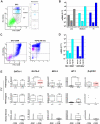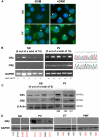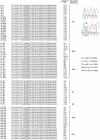The dominant negative β isoform of the glucocorticoid receptor is uniquely expressed in erythroid cells expanded from polycythemia vera patients
- PMID: 21355091
- PMCID: PMC3138692
- DOI: 10.1182/blood-2010-07-296921
The dominant negative β isoform of the glucocorticoid receptor is uniquely expressed in erythroid cells expanded from polycythemia vera patients
Abstract
Glucocorticoid receptor (GR) agonists increase erythropoiesis in vivo and in vitro. To clarify the effect of the dominant negative GRβ isoform (unable to bind STAT-5) on erythropoiesis, erythroblast (EB) expansion cultures of mononuclear cells from 18 healthy (nondiseased) donors (NDs) and 16 patients with polycythemia vera (PV) were studied. GRβ was expressed in all PV EBs but only in EBs from 1 ND. The A3669G polymorphism, which stabilizes GRβ mRNA, had greater frequency in PV (55%; n = 22; P = .0028) and myelofibrosis (35%; n = 20) patients than in NDs (9%; n = 22) or patients with essential thrombocythemia (6%; n = 15). Dexamethasone stimulation of ND cultures increased the number of immature EBs characterized by low GATA1 and β-globin expression, but PV cultures generated great numbers of immature EBs with low levels of GATA1 and β-globin irrespective of dexamethasone stimulation. In ND EBs, STAT-5 was not phosphorylated after dexamethasone and erythropoietin treatment and did not form transcriptionally active complexes with GRα, whereas in PV EBs, STAT-5 was constitutively phosphorylated, but the formation of GR/STAT-5 complexes was prevented by expression of GRβ. These data indicate that GRβ expression and the presence of A3669G likely contribute to development of erythrocytosis in PV and provide a potential target for identification of novel therapeutic agents.
Figures






Similar articles
-
Transcriptomic and phospho-proteomic analyzes of erythroblasts expanded in vitro from normal donors and from patients with polycythemia vera.Am J Hematol. 2013 Sep;88(9):723-9. doi: 10.1002/ajh.23487. Epub 2013 Jul 3. Am J Hematol. 2013. PMID: 23720412 Free PMC article.
-
The Calreticulin control of human stress erythropoiesis is impaired by JAK2V617F in polycythemia vera.Exp Hematol. 2017 Jun;50:53-76. doi: 10.1016/j.exphem.2017.02.001. Epub 2017 Feb 21. Exp Hematol. 2017. PMID: 28232234 Free PMC article.
-
The JAK2 617V>F mutation triggers erythropoietin hypersensitivity and terminal erythroid amplification in primary cells from patients with polycythemia vera.Blood. 2007 Aug 1;110(3):1013-21. doi: 10.1182/blood-2006-10-054940. Epub 2007 Mar 27. Blood. 2007. PMID: 17389763
-
Current diagnostic criteria for the chronic myeloproliferative disorders (MPD) essential thrombocythemia (ET), polycythemia vera (PV) and chronic idiopathic myelofibrosis (CIMF).Pathol Biol (Paris). 2007 Mar;55(2):92-104. doi: 10.1016/j.patbio.2006.06.002. Epub 2006 Aug 21. Pathol Biol (Paris). 2007. PMID: 16919893 Review.
-
The role of JAK2 V617F mutation, spontaneous erythropoiesis and megakaryocytopoiesis, hypersensitive platelets, activated leukocytes, and endothelial cells in the etiology of thrombotic manifestations in polycythemia vera and essential thrombocythemia.Semin Thromb Hemost. 2006 Jun;32(4 Pt 2):381-98. doi: 10.1055/s-2006-942759. Semin Thromb Hemost. 2006. PMID: 16810614 Review.
Cited by
-
The Genetic Makeup of Myeloproliferative Neoplasms: Role of Germline Variants in Defining Disease Risk, Phenotypic Diversity and Outcome.Cells. 2021 Sep 29;10(10):2597. doi: 10.3390/cells10102597. Cells. 2021. PMID: 34685575 Free PMC article. Review.
-
Generating diversity in human glucocorticoid signaling through a racially diverse polymorphism in the beta isoform of the glucocorticoid receptor.Lab Invest. 2017 Nov;97(11):1282-1295. doi: 10.1038/labinvest.2017.76. Epub 2017 Jul 31. Lab Invest. 2017. PMID: 28759007 Free PMC article.
-
Phosphoproteomic Landscaping Identifies Non-canonical cKIT Signaling in Polycythemia Vera Erythroid Progenitors.Front Oncol. 2019 Nov 22;9:1245. doi: 10.3389/fonc.2019.01245. eCollection 2019. Front Oncol. 2019. PMID: 31824842 Free PMC article.
-
Identification of NuRSERY, a new functional HDAC complex composed by HDAC5, GATA1, EKLF and pERK present in human erythroid cells.Int J Biochem Cell Biol. 2014 May;50:112-22. doi: 10.1016/j.biocel.2014.02.019. Epub 2014 Mar 1. Int J Biochem Cell Biol. 2014. PMID: 24594363 Free PMC article.
-
Glucocorticoid receptor β stimulates Akt1 growth pathway by attenuation of PTEN.J Biol Chem. 2014 Jun 20;289(25):17885-94. doi: 10.1074/jbc.M113.544072. Epub 2014 May 9. J Biol Chem. 2014. PMID: 24817119 Free PMC article.
References
-
- Adamson JW, Fialkow PJ, Murphy S, Prchal JF, Steinmann L. Polycythemia vera: stem-cell and probable clonal origin of the disease. N Engl J Med. 1976;295(17):913–916. - PubMed
-
- Baxter EJ, Scott LM, Campbell PJ, et al. Acquired mutation of the tyrosine kinase JAK2 in human myeloproliferative disorders. Lancet. 2005;365(8):1054–1061. - PubMed
-
- James C, Ugo V, Le Couedic JP, et al. A unique clonal JAK2 mutation leading to constitutive signalling causes polycythaemia vera. Nature. 2005;434(7037):1144–1148. - PubMed
-
- Levine RL, Wadleigh M, Cools J, et al. Activating mutation in the tyrosine kinase JAK2 in polycythemia vera, essential thrombocythemia, and myeloid metaplasia with myelofibrosis. Cancer Cell. 2005;7(4):387–397. - PubMed
-
- Constantinescu SN, Ghaffari S, Lodish HF. The erythropoietin receptor: structure, activation and intracellular signal transduction. Trends Endocrinol Metab. 1999;10(1):18–23. - PubMed
Publication types
MeSH terms
Substances
Grants and funding
LinkOut - more resources
Full Text Sources
Miscellaneous

